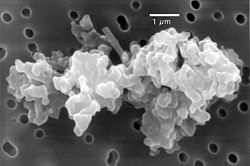Pył międzyplanetarny
Pył międzyplanetarny – rodzaj pyłu kosmicznego, znajdujący się w przestrzeni międzyplanetarnej, to jest w przestrzeni pomiędzy planetami Układu Słonecznego lub innego układu planetarnego. Jednym z przejawów istnienia pyłu międzyplanetarnego jest występowanie światła zodiakalnego.
Źródła pyłu międzyplanetarnego
Źródłem pyłu międzyplanetarnego jest fragmentaryzacja mniejszych ciał Układu Słonecznego, w szczególności zaś:
- kolizje planetoid i meteoroid
- aktywność i rozpad komet
- kolizje wewnątrz pasa Kuipera
- napływ pyłu międzygwiazdowego
Wielkość ziaren pyłu
W ogólności za pył międzyplanetarny uznaje się cząstki o rozmiarach od około 10-8 m do około 10-3 m[1] (0,01–1000 µm).
Pył międzyplanetarny oświetlany promieniowaniem Słońca emituje promieniowanie w zakresie podczerwieni (promieniowanie termiczne) oraz w zakresie widzialnym (światło zodiakalne). Umożliwia to oszacowanie wielkości ziaren pyłu międzyplanetarnego w zakresie 20–200 µm[1][2][3][4]. Większe ziarna są określane już jako meteoroidy[5]. Wielkość ziaren pyłu międzyplanetarnego można też określić badając okazy, które przeniknęły do atmosfery ziemskiej.

Przypisy
- ↑ a b Mark V. Sykes, Eberhard Grün, William T. Reach, Peter Jenniskens: Comets II: The interplanetary dust complex and comets. Tucson: University of Arizona Press, 2004, s. 677-693. [dostęp 2014-07-22]. (ang.)
- ↑ William T. Reach. Zodiacal emission. I - Dust near the earth's orbit. „Astrophysical Journal”. 335, s. 468-485, 1988. DOI: 10.1086/166940 (ang.). [dostęp 2014-07-22].
- ↑ William T. Reach. Zodiacal emission. II - Dust near ecliptic. „Astrophysical Journal”. 369, s. 529-543, 1991. DOI: 10.1086/169782 (ang.). [dostęp 2014-07-22].
- ↑ William T. Reach. Zodiacal emission. III - Dust near the asteroid belt. „Astrophysical Journal”. 392 (1), s. 289-299, 1992. DOI: 10.1086/171428 (ang.). [dostęp 2014-07-22].
- ↑ Martin Beech, Duncan Steel. On the Definition of the Term Meteoroid. „Quarterly Journal of the Royal Astronomical Society”. 36 (3), s. 281-284, 1995 (ang.). [dostęp 2014-07-22].
Media użyte na tej stronie
Autor: Oryginalnym przesyłającym był Amara z angielskiej Wikipedii, Licencja: CC BY 1.0
This is a scanning electron microscope image of an interplanetary dust particle that has roughly chondritic elemental composition and is highly rough (chondritic porous: "CP"). CP types are usually aggregates of large numbers of sub-micrometer grains, clustered in a random open order. The authors of this figure are Donald E. Brownlee, University of Washington, Seattle, and Elmar Jessberger, Institut für Planetologie, Münster, Germany.
This file is licensed under Creative Commons Attribution 2.5 License: https://creativecommons.org/licenses/by/2.5/ See the (Jessberger chapter in Grün, E., Gustafson, B.A.S., Dermott, S.F., Fechtig, H. (Eds.) Interplanetary Dust book for more details on this kind of dust particle.
References
- E. K. Jessberger, T. Stephan, D. Rost, P. Arndt, M. Maetz, F. J. Stadermann, D. E. Brownlee, J. P. Bradley, G. Kurat (2001). Properties of Interplanetary Dust: Information from Collected Samples, in Grün, E., Gustafson, B.A.S., Dermott, S.F., Fechtig, H. (Eds.) Interplanetary Dust, pp. 253–294, Springer-Verlag.
